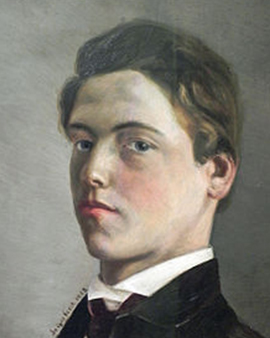


The sweeping brushstrokes and play of light and shadow that unfold on the canvases of Wilhelm Maria Hubertus Leibl carry the quiet melodies of everyday life and the unvarnished character of life itself. Born in Cologne on October 23, 1844 and passed away in Würzburg on December 4, 1900, Leibl cemented his legacy as an authoritative exponent of realism in Germany, a legacy that is reflected in each of our art prints. Wilhelm Leibl, the fifth of six children of cathedral chapel master Carl Leibl, began his journey into the art world after dropping out of a locksmith apprenticeship. He learned his first brushstrokes from Hermann Becker in Cologne before continuing his studies at the Royal Academy of Art in Munich. There he studied under renowned teachers such as Hermann Anschütz, Alexander Strähuber, Arthur Georg von Ramberg and Karl Theodor von Piloty. However, it was his meeting and friendship with Gustave Courbet that significantly shaped his artistic journey. The Portrait of Mrs. Gedon (1868/69), one of his major works from this early period and now a sought-after art print, brought him into close contact with Courbet and his realistic painting.
As an artist, Leibl was always looking for like-minded souls. In 1870, he gathered around him a group of artists, the Leibl Circle, in Munich, including Wilhelm Trübner, Carl Schuch and Theodor Alt. Although he withdrew from the Munich art scene beginning in 1873, he never let his passion get away from him. He retired to Upper Bavaria with the painter Johann Sperl and continued his work. Working in the great outdoors allowed Leibl to capture the subtle nuances of natural light and achieve an amazing level of detail in his works, a quality that also comes through in our art prints of Leibl's work.
Wilhelm Leibl's works are not only an accurate representation of the world as it is, but also a passionate tribute to ordinary life. His detailed painting, which approached Impressionism from 1890, was always characterized by a closed physicality of his figures. Leibl was above all a portrayer of people. His works, such as the famous "The Three Women in Church" (1881), are a testament to his incredible talent as a painter and his unparalleled ability to capture the genuine nature of people. We are proud to offer his stunning works in our collection of fine art prints, reproduced with the highest possible attention to quality and detail to do justice to Leibl's masterful works. Today, Wilhelm Leibl's works remain a fascinating window into the past as well as a reflection of human nature. Each art print representing his work bears the marks of his artistic journey and lifelong passion for art. With the utmost care and quality inherent in our art prints, we strive to carry on this legacy and keep the spirit of Wilhelm Leibl's art alive for generations to come.

The sweeping brushstrokes and play of light and shadow that unfold on the canvases of Wilhelm Maria Hubertus Leibl carry the quiet melodies of everyday life and the unvarnished character of life itself. Born in Cologne on October 23, 1844 and passed away in Würzburg on December 4, 1900, Leibl cemented his legacy as an authoritative exponent of realism in Germany, a legacy that is reflected in each of our art prints. Wilhelm Leibl, the fifth of six children of cathedral chapel master Carl Leibl, began his journey into the art world after dropping out of a locksmith apprenticeship. He learned his first brushstrokes from Hermann Becker in Cologne before continuing his studies at the Royal Academy of Art in Munich. There he studied under renowned teachers such as Hermann Anschütz, Alexander Strähuber, Arthur Georg von Ramberg and Karl Theodor von Piloty. However, it was his meeting and friendship with Gustave Courbet that significantly shaped his artistic journey. The Portrait of Mrs. Gedon (1868/69), one of his major works from this early period and now a sought-after art print, brought him into close contact with Courbet and his realistic painting.
As an artist, Leibl was always looking for like-minded souls. In 1870, he gathered around him a group of artists, the Leibl Circle, in Munich, including Wilhelm Trübner, Carl Schuch and Theodor Alt. Although he withdrew from the Munich art scene beginning in 1873, he never let his passion get away from him. He retired to Upper Bavaria with the painter Johann Sperl and continued his work. Working in the great outdoors allowed Leibl to capture the subtle nuances of natural light and achieve an amazing level of detail in his works, a quality that also comes through in our art prints of Leibl's work.
Wilhelm Leibl's works are not only an accurate representation of the world as it is, but also a passionate tribute to ordinary life. His detailed painting, which approached Impressionism from 1890, was always characterized by a closed physicality of his figures. Leibl was above all a portrayer of people. His works, such as the famous "The Three Women in Church" (1881), are a testament to his incredible talent as a painter and his unparalleled ability to capture the genuine nature of people. We are proud to offer his stunning works in our collection of fine art prints, reproduced with the highest possible attention to quality and detail to do justice to Leibl's masterful works. Today, Wilhelm Leibl's works remain a fascinating window into the past as well as a reflection of human nature. Each art print representing his work bears the marks of his artistic journey and lifelong passion for art. With the utmost care and quality inherent in our art prints, we strive to carry on this legacy and keep the spirit of Wilhelm Leibl's art alive for generations to come.
Page 1 / 1






